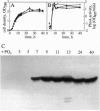Abstract
We have examined the positive influence of human constant regions on the folding and bacterial expression of active soluble mouse immunoglobulin variable domains derived from a number of catalytic antibodies. Expression yields of eight hybridoma- and myeloma-derived chimeric Fab fragments are compared in both shake flasks and high density fermentations. In addition the usefulness of this system for the generation of in vivo expression libraries is examined by constructing and expressing combinations of heavy and light chain variable regions that were not selected as a pair during an immune response. A mutagenesis study of one of the recombinant catalytic Fab fragments reveals that single amino acid substitutions can have dramatic effects on the expression yield. This system should be generally applicable to the production of Fab fragments of catalytic and other hybridoma-derived antibodies for crystallographic and structure-function studies.
Full text
PDF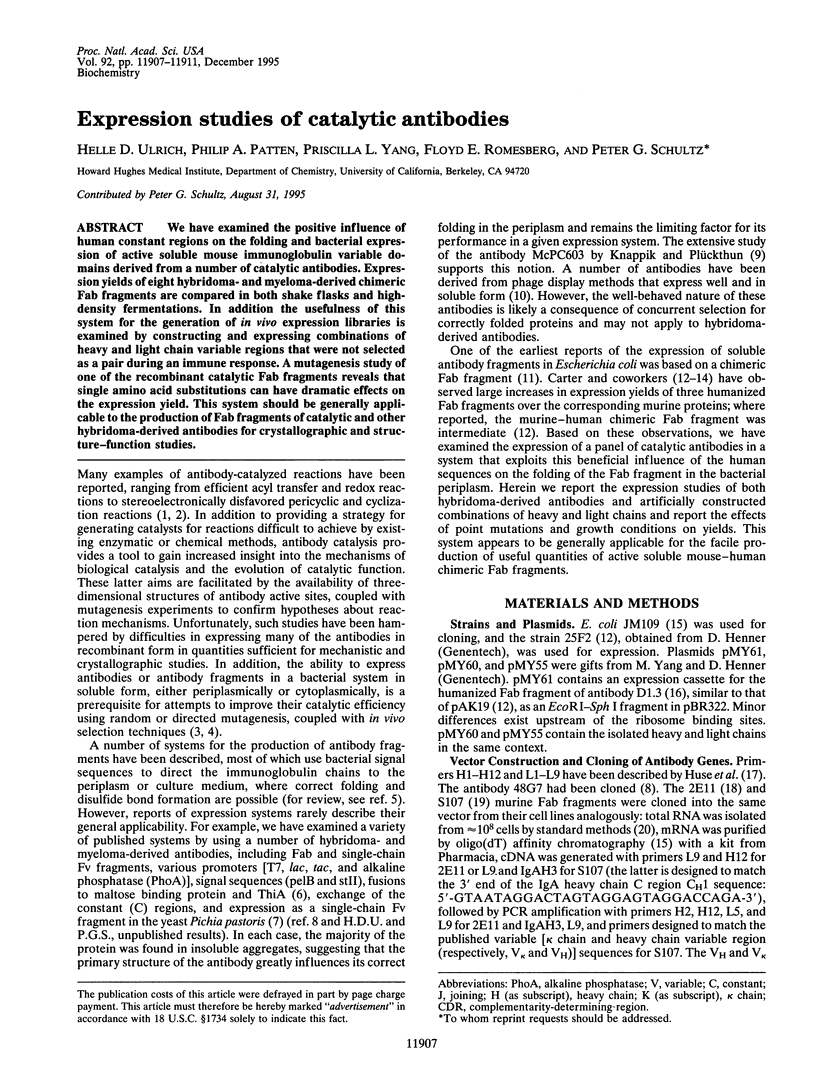
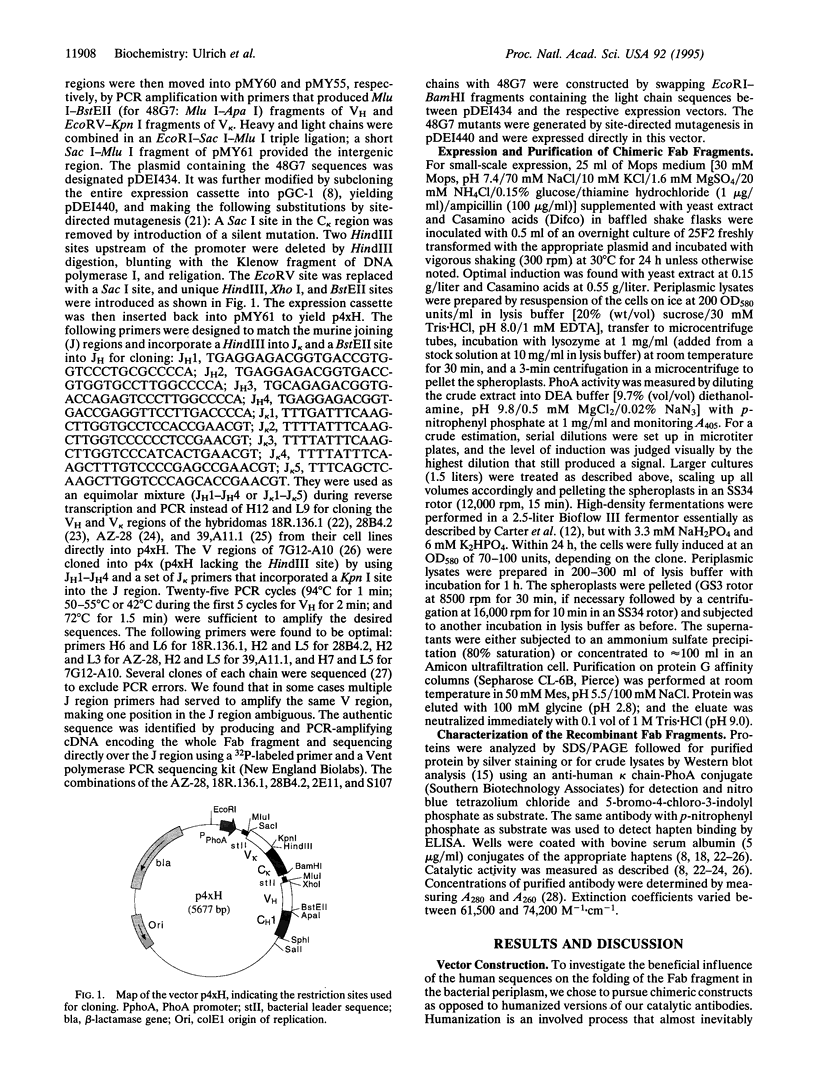
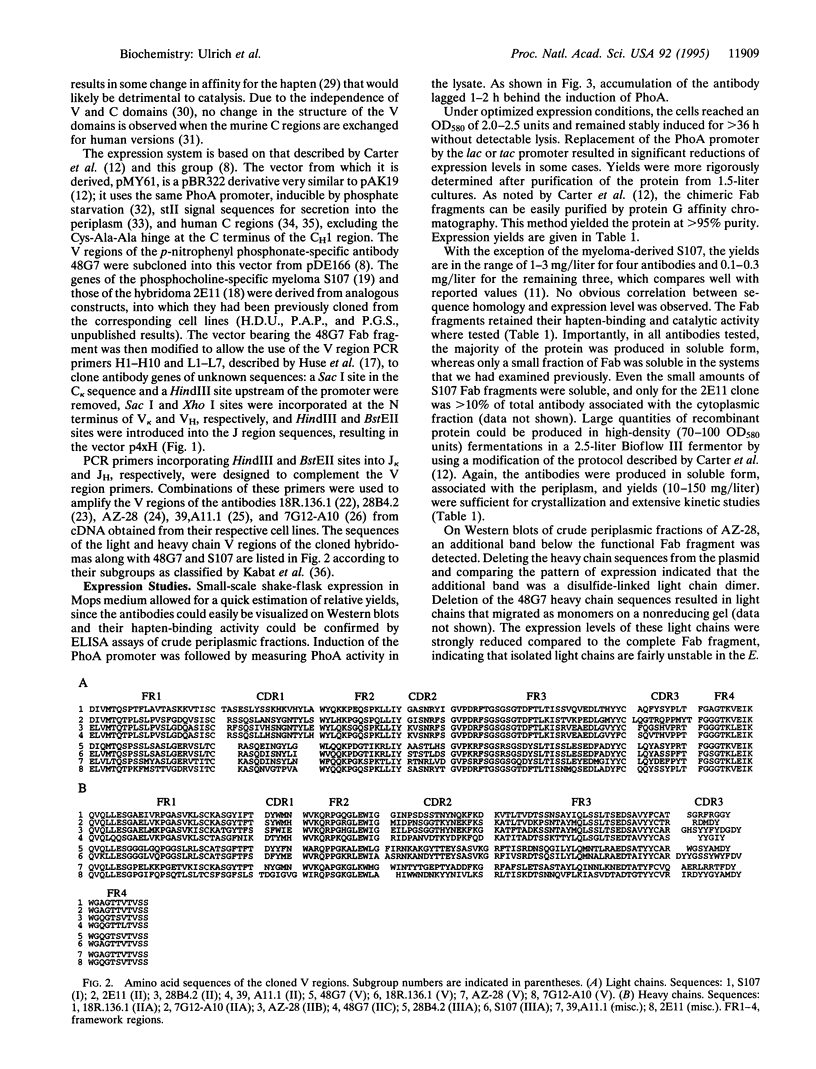
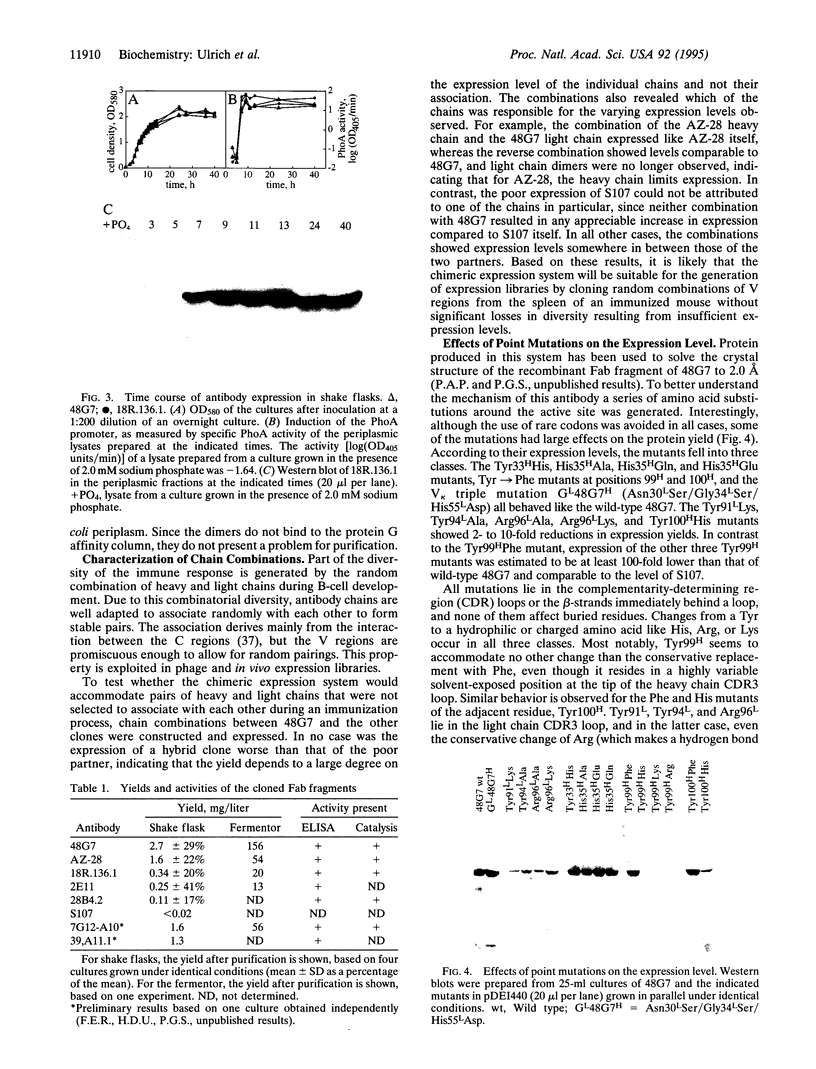
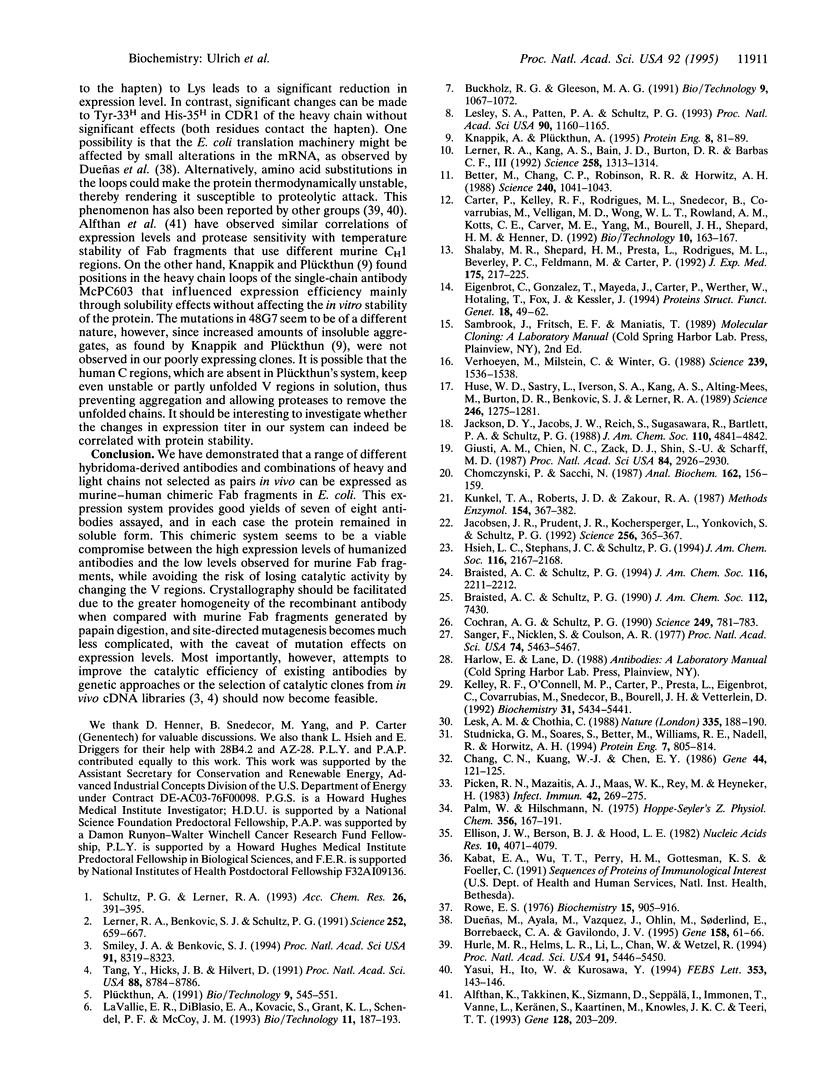
Images in this article
Selected References
These references are in PubMed. This may not be the complete list of references from this article.
- Alfthan K., Takkinen K., Sizmann D., Seppälä I., Immonen T., Vanne L., Keränen S., Kaartinen M., Knowles J. K., Teeri T. T. Efficient secretion of murine Fab fragments by Escherichia coli is determined by the first constant domain of the heavy chain. Gene. 1993 Jun 30;128(2):203–209. doi: 10.1016/0378-1119(93)90564-j. [DOI] [PubMed] [Google Scholar]
- Bach L. A., Hsieh S., Brown A. L., Rechler M. M. Recombinant human insulin-like growth factor (IGF)-binding protein-6 inhibits IGF-II-induced differentiation of L6A1 myoblasts. Endocrinology. 1994 Nov;135(5):2168–2176. doi: 10.1210/endo.135.5.7525263. [DOI] [PubMed] [Google Scholar]
- Better M., Chang C. P., Robinson R. R., Horwitz A. H. Escherichia coli secretion of an active chimeric antibody fragment. Science. 1988 May 20;240(4855):1041–1043. doi: 10.1126/science.3285471. [DOI] [PubMed] [Google Scholar]
- Buckholz R. G., Gleeson M. A. Yeast systems for the commercial production of heterologous proteins. Biotechnology (N Y) 1991 Nov;9(11):1067–1072. doi: 10.1038/nbt1191-1067. [DOI] [PubMed] [Google Scholar]
- Carter P., Kelley R. F., Rodrigues M. L., Snedecor B., Covarrubias M., Velligan M. D., Wong W. L., Rowland A. M., Kotts C. E., Carver M. E. High level Escherichia coli expression and production of a bivalent humanized antibody fragment. Biotechnology (N Y) 1992 Feb;10(2):163–167. doi: 10.1038/nbt0292-163. [DOI] [PubMed] [Google Scholar]
- Chang C. N., Kuang W. J., Chen E. Y. Nucleotide sequence of the alkaline phosphatase gene of Escherichia coli. Gene. 1986;44(1):121–125. doi: 10.1016/0378-1119(86)90050-8. [DOI] [PubMed] [Google Scholar]
- Chomczynski P., Sacchi N. Single-step method of RNA isolation by acid guanidinium thiocyanate-phenol-chloroform extraction. Anal Biochem. 1987 Apr;162(1):156–159. doi: 10.1006/abio.1987.9999. [DOI] [PubMed] [Google Scholar]
- Cochran A. G., Schultz P. G. Antibody-catalyzed porphyrin metallation. Science. 1990 Aug 17;249(4970):781–783. doi: 10.1126/science.2389144. [DOI] [PubMed] [Google Scholar]
- Dueñas M., Ayala M., Vázquez J., Ohlin M., Söderlind E., Borrebaeck C. A., Gavilondo J. V. A point mutation in a murine immunoglobulin V-region strongly influences the antibody yield in Escherichia coli. Gene. 1995 May 26;158(1):61–66. doi: 10.1016/0378-1119(95)00077-j. [DOI] [PubMed] [Google Scholar]
- Eigenbrot C., Gonzalez T., Mayeda J., Carter P., Werther W., Hotaling T., Fox J., Kessler J. X-ray structures of fragments from binding and nonbinding versions of a humanized anti-CD18 antibody: structural indications of the key role of VH residues 59 to 65. Proteins. 1994 Jan;18(1):49–62. doi: 10.1002/prot.340180107. [DOI] [PubMed] [Google Scholar]
- Ellison J. W., Berson B. J., Hood L. E. The nucleotide sequence of a human immunoglobulin C gamma1 gene. Nucleic Acids Res. 1982 Jul 10;10(13):4071–4079. doi: 10.1093/nar/10.13.4071. [DOI] [PMC free article] [PubMed] [Google Scholar]
- Giusti A. M., Chien N. C., Zack D. J., Shin S. U., Scharff M. D. Somatic diversification of S107 from an antiphosphocholine to an anti-DNA autoantibody is due to a single base change in its heavy chain variable region. Proc Natl Acad Sci U S A. 1987 May;84(9):2926–2930. doi: 10.1073/pnas.84.9.2926. [DOI] [PMC free article] [PubMed] [Google Scholar]
- Hurle M. R., Helms L. R., Li L., Chan W., Wetzel R. A role for destabilizing amino acid replacements in light-chain amyloidosis. Proc Natl Acad Sci U S A. 1994 Jun 7;91(12):5446–5450. doi: 10.1073/pnas.91.12.5446. [DOI] [PMC free article] [PubMed] [Google Scholar]
- Huse W. D., Sastry L., Iverson S. A., Kang A. S., Alting-Mees M., Burton D. R., Benkovic S. J., Lerner R. A. Generation of a large combinatorial library of the immunoglobulin repertoire in phage lambda. Science. 1989 Dec 8;246(4935):1275–1281. doi: 10.1126/science.2531466. [DOI] [PubMed] [Google Scholar]
- Jacobsen J. R., Prudent J. R., Kochersperger L., Yonkovich S., Schultz P. G. An efficient antibody-catalyzed aminoacylation reaction. Science. 1992 Apr 17;256(5055):365–367. doi: 10.1126/science.256.5055.365. [DOI] [PubMed] [Google Scholar]
- Kelley R. F., O'Connell M. P., Carter P., Presta L., Eigenbrot C., Covarrubias M., Snedecor B., Bourell J. H., Vetterlein D. Antigen binding thermodynamics and antiproliferative effects of chimeric and humanized anti-p185HER2 antibody Fab fragments. Biochemistry. 1992 Jun 23;31(24):5434–5441. doi: 10.1021/bi00139a003. [DOI] [PubMed] [Google Scholar]
- Knappik A., Plückthun A. Engineered turns of a recombinant antibody improve its in vivo folding. Protein Eng. 1995 Jan;8(1):81–89. doi: 10.1093/protein/8.1.81. [DOI] [PubMed] [Google Scholar]
- Kunkel T. A., Roberts J. D., Zakour R. A. Rapid and efficient site-specific mutagenesis without phenotypic selection. Methods Enzymol. 1987;154:367–382. doi: 10.1016/0076-6879(87)54085-x. [DOI] [PubMed] [Google Scholar]
- LaVallie E. R., DiBlasio E. A., Kovacic S., Grant K. L., Schendel P. F., McCoy J. M. A thioredoxin gene fusion expression system that circumvents inclusion body formation in the E. coli cytoplasm. Biotechnology (N Y) 1993 Feb;11(2):187–193. doi: 10.1038/nbt0293-187. [DOI] [PubMed] [Google Scholar]
- Lerner R. A., Benkovic S. J., Schultz P. G. At the crossroads of chemistry and immunology: catalytic antibodies. Science. 1991 May 3;252(5006):659–667. doi: 10.1126/science.2024118. [DOI] [PubMed] [Google Scholar]
- Lerner R. A., Kang A. S., Bain J. D., Burton D. R., Barbas C. F., 3rd Antibodies without immunization. Science. 1992 Nov 20;258(5086):1313–1314. doi: 10.1126/science.1455226. [DOI] [PubMed] [Google Scholar]
- Lesk A. M., Chothia C. Elbow motion in the immunoglobulins involves a molecular ball-and-socket joint. Nature. 1988 Sep 8;335(6186):188–190. doi: 10.1038/335188a0. [DOI] [PubMed] [Google Scholar]
- Lesley S. A., Patten P. A., Schultz P. G. A genetic approach to the generation of antibodies with enhanced catalytic activities. Proc Natl Acad Sci U S A. 1993 Feb 15;90(4):1160–1165. doi: 10.1073/pnas.90.4.1160. [DOI] [PMC free article] [PubMed] [Google Scholar]
- Palm W., Hilschmann N. Die Primärstruktur einer kristallinen monoklonalen Immunglobulin-L-Kette vom kappa-Typ, Subgruppe I(Bence-Jones Protein Rei.), Isoleirung und Charakteristierung der tryptischen Peptide; die vollständige Aminosäuresequenz des Proteins. Ein Beitrag zue Aufklärung der räumlichen Struktur der Antikörper, insbesondere der Haftstelle. Hoppe Seylers Z Physiol Chem. 1975 Feb;356(2):167–191. [PubMed] [Google Scholar]
- Picken R. N., Mazaitis A. J., Maas W. K., Rey M., Heyneker H. Nucleotide sequence of the gene for heat-stable enterotoxin II of Escherichia coli. Infect Immun. 1983 Oct;42(1):269–275. doi: 10.1128/iai.42.1.269-275.1983. [DOI] [PMC free article] [PubMed] [Google Scholar]
- Plückthun A. Antibody engineering: advances from the use of Escherichia coli expression systems. Biotechnology (N Y) 1991 Jun;9(6):545–551. doi: 10.1038/nbt0691-545. [DOI] [PubMed] [Google Scholar]
- Rowe E. S. Dissociation and denaturation equilibria and kinetics of a homogeneous human immunoglobulin Fab fragment. Biochemistry. 1976 Feb 24;15(4):905–916. doi: 10.1021/bi00649a028. [DOI] [PubMed] [Google Scholar]
- Sanger F., Nicklen S., Coulson A. R. DNA sequencing with chain-terminating inhibitors. Proc Natl Acad Sci U S A. 1977 Dec;74(12):5463–5467. doi: 10.1073/pnas.74.12.5463. [DOI] [PMC free article] [PubMed] [Google Scholar]
- Shalaby M. R., Shepard H. M., Presta L., Rodrigues M. L., Beverley P. C., Feldmann M., Carter P. Development of humanized bispecific antibodies reactive with cytotoxic lymphocytes and tumor cells overexpressing the HER2 protooncogene. J Exp Med. 1992 Jan 1;175(1):217–225. doi: 10.1084/jem.175.1.217. [DOI] [PMC free article] [PubMed] [Google Scholar]
- Smiley J. A., Benkovic S. J. Selection of catalytic antibodies for a biosynthetic reaction from a combinatorial cDNA library by complementation of an auxotrophic Escherichia coli: antibodies for orotate decarboxylation. Proc Natl Acad Sci U S A. 1994 Aug 30;91(18):8319–8323. doi: 10.1073/pnas.91.18.8319. [DOI] [PMC free article] [PubMed] [Google Scholar]
- Studnicka G. M., Soares S., Better M., Williams R. E., Nadell R., Horwitz A. H. Human-engineered monoclonal antibodies retain full specific binding activity by preserving non-CDR complementarity-modulating residues. Protein Eng. 1994 Jun;7(6):805–814. doi: 10.1093/protein/7.6.805. [DOI] [PubMed] [Google Scholar]
- Tang Y., Hicks J. B., Hilvert D. In vivo catalysis of a metabolically essential reaction by an antibody. Proc Natl Acad Sci U S A. 1991 Oct 1;88(19):8784–8786. doi: 10.1073/pnas.88.19.8784. [DOI] [PMC free article] [PubMed] [Google Scholar]
- Verhoeyen M., Milstein C., Winter G. Reshaping human antibodies: grafting an antilysozyme activity. Science. 1988 Mar 25;239(4847):1534–1536. doi: 10.1126/science.2451287. [DOI] [PubMed] [Google Scholar]
- Yasui H., Ito W., Kurosawa Y. Effects of substitutions of amino acids on the thermal stability of the Fv fragments of antibodies. FEBS Lett. 1994 Oct 17;353(2):143–146. doi: 10.1016/0014-5793(94)01027-7. [DOI] [PubMed] [Google Scholar]



